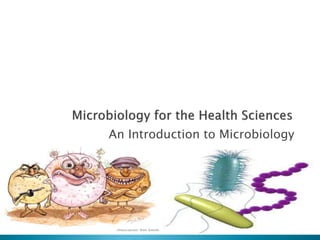E-content microbiology-2.ppt
•Download as PPT, PDF•
0 likes•14 views
This document provides an overview of microbiology and discusses the classification and roles of microorganisms. It describes how Carolus Linnaeus developed the first taxonomic system for classifying microbes into six categories including fungi, protozoa, algae, bacteria, archaea, and small animals. It also summarizes key discoveries and advances in microbiology such as Pasteur's germ theory of disease, Koch's studies of disease-causing agents, and the fields of biochemistry, genetics, and gene therapy which utilize microbes.
Report
Share
Report
Share

Recommended
Recommended
More Related Content
Similar to E-content microbiology-2.ppt
Similar to E-content microbiology-2.ppt (20)
Introduction to Microbiology and Classification of Microorganisms.pptx

Introduction to Microbiology and Classification of Microorganisms.pptx
composition of the microbial world and turning points in microbiological rese...

composition of the microbial world and turning points in microbiological rese...
Recently uploaded
https://app.box.com/s/x7vf0j7xaxl2hlczxm3ny497y4yto33i80 ĐỀ THI THỬ TUYỂN SINH TIẾNG ANH VÀO 10 SỞ GD – ĐT THÀNH PHỐ HỒ CHÍ MINH NĂ...

80 ĐỀ THI THỬ TUYỂN SINH TIẾNG ANH VÀO 10 SỞ GD – ĐT THÀNH PHỐ HỒ CHÍ MINH NĂ...Nguyen Thanh Tu Collection
Recently uploaded (20)
This PowerPoint helps students to consider the concept of infinity.

This PowerPoint helps students to consider the concept of infinity.
Basic Civil Engineering first year Notes- Chapter 4 Building.pptx

Basic Civil Engineering first year Notes- Chapter 4 Building.pptx
On National Teacher Day, meet the 2024-25 Kenan Fellows

On National Teacher Day, meet the 2024-25 Kenan Fellows
ICT Role in 21st Century Education & its Challenges.pptx

ICT Role in 21st Century Education & its Challenges.pptx
80 ĐỀ THI THỬ TUYỂN SINH TIẾNG ANH VÀO 10 SỞ GD – ĐT THÀNH PHỐ HỒ CHÍ MINH NĂ...

80 ĐỀ THI THỬ TUYỂN SINH TIẾNG ANH VÀO 10 SỞ GD – ĐT THÀNH PHỐ HỒ CHÍ MINH NĂ...
Interdisciplinary_Insights_Data_Collection_Methods.pptx

Interdisciplinary_Insights_Data_Collection_Methods.pptx
Beyond_Borders_Understanding_Anime_and_Manga_Fandom_A_Comprehensive_Audience_...

Beyond_Borders_Understanding_Anime_and_Manga_Fandom_A_Comprehensive_Audience_...
Food safety_Challenges food safety laboratories_.pdf

Food safety_Challenges food safety laboratories_.pdf
Sensory_Experience_and_Emotional_Resonance_in_Gabriel_Okaras_The_Piano_and_Th...

Sensory_Experience_and_Emotional_Resonance_in_Gabriel_Okaras_The_Piano_and_Th...
E-content microbiology-2.ppt
- 1. M I C R O B I O L O G Y WITH DISEASES BY BODY SYSTEM SECOND EDITION An Introduction to Microbiology
- 2. Microbiology: The study of living things too small to be seen without magnification ◦ Microorganisms or microbes- these microscopic organisms ◦ Commonly called “germs, viruses, agents…” but not all cause disease and many more are useful or essential for human life
- 3. How Can Microbes Be Classified? Carolus Linnaeus (Swedish) developed taxonomic system for naming plants and animals and grouping similar organisms together Leeuwenhoek’s microorganisms grouped into six categories as follows: Fungi Protozoa Algae Bacteria Archaea Small animals
- 4. Fungi ◦ Eukaryotic (have membrane- bound nucleus) ◦ Obtain food from other organisms ◦ Possess cell walls ◦ Composed of Molds – multicellular; have hyphae; reproduce by sexual and asexual spores Yeasts – unicellular; reproduce asexually by budding; some produce sexual spores
- 5. Protozoa ◦ Single-celled eukaryotes ◦ Similar to animals in nutrient needs and cellular structure ◦ Live freely in water; some live in animal hosts ◦ Asexual (most) and sexual reproduction ◦ Most are capable of locomotion by Pseudopodia – cell extensions that flow in direction of travel Cilia – numerous, short, hairlike protrusions that propel organisms through environment Flagella – extensions of a cell that are fewer, longer, and more whiplike than cilia
- 6. Algae ◦ Unicellular or multicellular ◦ Photosynthetic ◦ Simple reproductive structures ◦ Categorized on the basis of pigmentation, storage products, and composition of cell wall
- 7. Pasteur’s Experiments ◦ When the “swan-necked flasks” remained upright, no microbial growth appeared ◦ When the flask was tilted, dust from the bend in the neck seeped back into the flask and made the infusion cloudy with microbes within a day
- 8. What Causes Disease? ◦ Pasteur developed germ theory of disease ◦ Robert Koch studied causative agents of disease Anthrax Examined colonies of microorganisms
- 9. How Can We Prevent Infection and Disease? ◦ Semmelweis and handwashing ◦ Lister’s antiseptic technique ◦ Nightingale and nursing ◦ Snow – infection control and epidemiology ◦ Jenner’s vaccine – field of immunology ◦ Ehrlich’s “magic bullets” – field of chemotherapy
- 10. What Are the Basic Chemical Reactions of Life? ◦ Biochemistry Began with Pasteur’s work on fermentation and Buchner’s discovery of enzymes in yeast extract Kluyver and van Niel – microbes used as model systems for biochemical reactions Practical applications Design of herbicides and pesticides Diagnosis of illnesses and monitoring of patients’ responses to treatment Treatment of metabolic diseases Drug design
- 11. How Do Genes Work? ◦ Microbial genetics ◦ Molecular biology ◦ Recombinant DNA technology ◦ Gene therapy
- 12. Recombinant DNA Technology ◦ Genes in microbes, plants, and animals manipulated for practical applications ◦ Production of human blood- clotting factor by E. coli to aid hemophiliacs Gene Therapy ◦ Inserting a missing gene or repairing a defective one in humans by inserting desired gene into host cells
- 13. What Role Do Microorganisms Play in the Environment? ◦ Bioremediation uses living bacteria, fungi, and algae to detoxify polluted environments ◦ Recycling of chemicals such as carbon, nitrogen, and sulfur
- 14. Autotrophic Heterotrophic Saprophytic or Saprobic